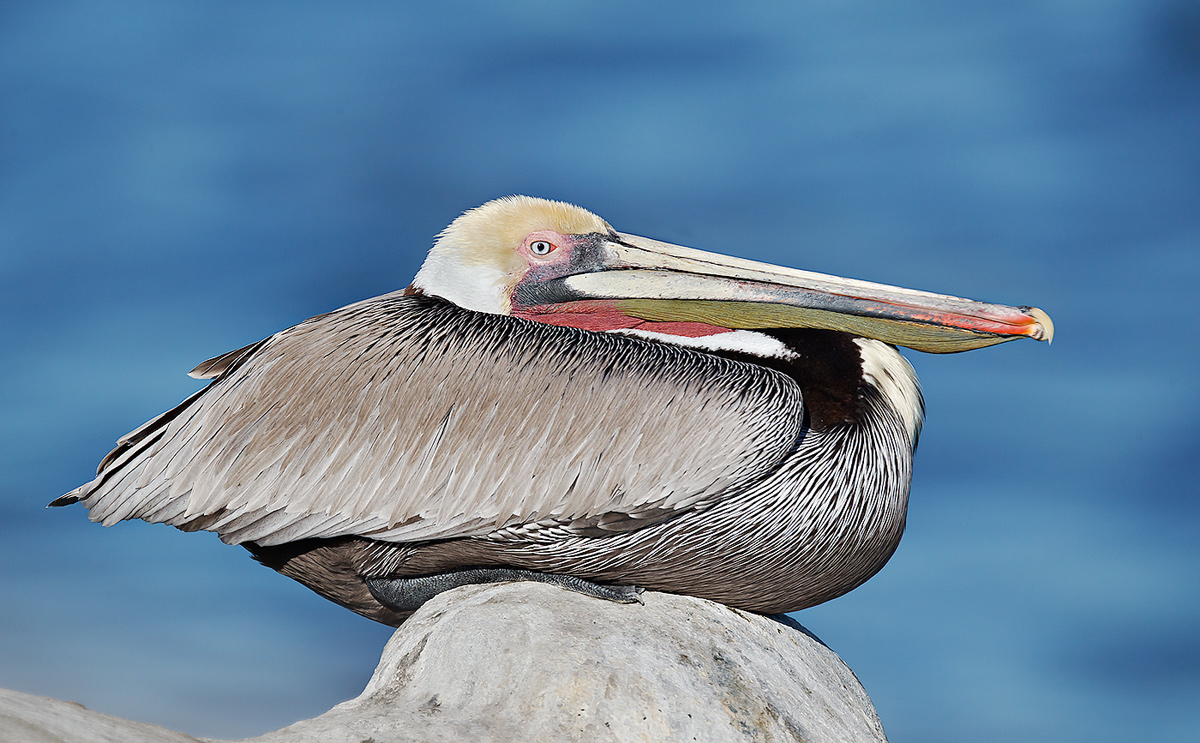
|
|
This Brown Pelican image was was created at LaJolla, CA in January 2011 with the Gitzo 3532 LS carbon fiber tripod, the Mongoose M3.6 head, the Canon EF 800mm f/5.6L IS USM Autofocus lens and the EOS-1D Mark IV now replaced by the Canon EOS-1D X. ISO 400. Evaluative metering at zero: 1/2000 sec. at f/8 in Av mode. Central sensor/Rear Focus AF on the bird’s eye and re-compose. Click here to see the latest version of the Rear Focus Tutorial. Click on the image to see a larger version. |
Gear Bag Discussion for a Big Trip
Denise Ippolito and I are taking 7 clients on a long-sold-out Japan in Winter IPT leaving the US on February 10th. Paul McKenzie who helped organize the trip–he lives in Hong Kong–is co-leading. There have been lots of questions about what lenses to bring. Below I share a few of the e-mails discussing just that subject. As you read the e-mails, do consider the images presented here and how they relate to the e-mails and to you.
From My First Gear e-Mail to the Group
Hi Gang,
I am in a quandary. The first (and last) time that I went to Japan I brought the 300 f/2.8 L IS II and the 800 for big glass. I did use the 800 a bit for head portraits of the eagles off the tripod–yes, on the boat and a lot for photographing the cranes in flight, often with the 1.4X TC. That said I made a ton of great images with the 300/1.4X TC combo and with the 70-200 II.
I no longer own the 800 having replaced it with the 600 f/4L IS II. And I also own the 200-400 with internal TC…
I am trying to decide whether to bring the 200-400 and perhaps a 300 II–the latter is lighter and much easier to hand hold and leave the 600 II at home…. The 2-4 with both TC gets me to 784mm. But the 600 with the 2X TC gets me to 1200, a huge advantage…. I expect that Paul will often have a shorter rather than a longer lens in his hands than me as he loves doing the wide environmental stuff…. I will be also bringing the 24-105 and leaving the fish eye at home….
So my big decision is whether to bring the 600 II or the 200-400 as my big lens. I am leaning towards the 600 II. If I do that I will almost surely buy a new 300 II and bring that so that I have something lighter for flight. The 2-4 would be great but it is heavier and it is nearly impossible to bring the 600 II, the 2-4, and the 300 II and all the rest. Heck, the 600II and the 300 II is load enough…
An option that I did not mention was to do the whole trip without a big super-telephoto, that is, to go only with the 300f/2.8L IS and both teleconverters…. For those considering bring a 200-400 the edge of course goes to the Canon version with the internal TC.
ps: bring lots of layers as the eagle boat might be brutally cold. I think that we had -5F one morning…. But there is a warm cabin.
pps: some might opt to do an afternoon trip at additional expense or possibly to do only one trip in the morning and one in the afternoon. We need six to get an afternoon boat but we could always recruit some other photographers….
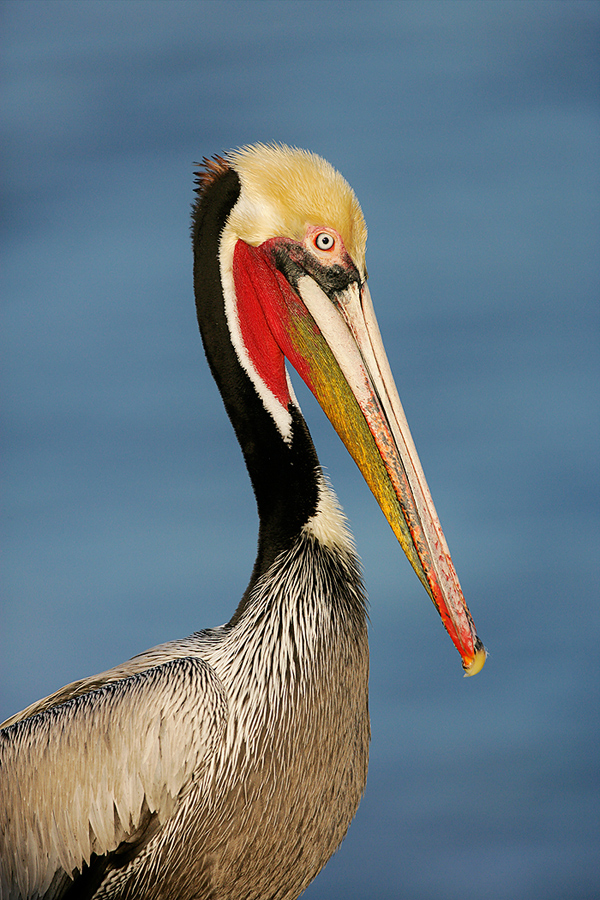
|
|
This breeding plumage Brown Pelican image was created at LaJolla, CA in January 2006 with the predecessor of the Gitzo 3532 LS carbon fiber tripod, the Mongoose M3.6 head, the 600mm f/4L IS lens) now replaced by the Canon EF 600mm f/4L IS II USM lens) and the EOS-1D Mark II (now replaced by the Canon EOS-1D X). ISO 400. Evaluative metering at zero in Av mode. Color temperature: Cloudy. Central sensor/Rear Focus AF on the bird’s eye and re-compose. Click here to see the latest version of the Rear Focus Tutorial. Click on the image to see a larger version. Note that as recently as 2011 I was working most often in Av mode rather than Manual mode… |
Early Morning Thoughts…
Hi Again All, Here I will share the thoughts that I was having as I awoke in a somewhat dream-like state this morning….
I have always been a long lens guy. I see the world in small rectangular frames as if I were always looking through a long telephoto lens. With a teleconverter. I love 3/4 frame images of whole birds and I love tight head portraits with clean backgrounds. Please remember that that is me. That is my style. I believe that Denise is much the same. I know that Paul tends to work much wider than I do using shorter focal length lenses so as to include lots of beautiful habitat. That said, I think that Paul had his the 600 when I last saw him in Japan. I might be wrong though….
If you brought only a 70-200 with TCs or an 80-400 or 100-400 without TCs or one of the Sigma 50-500s you will have countless opportunities to create great images on the Japan in Winter trip. Will you sometimes be wishing that you had a longer focal length? Of course. I often wish the same when standing behind my tripod-mounted 600 II with the 2X III attached. But do understand that intermediate focal length lenses above often have a huge advantage over long glass when it comes to photographing birds in flight and in action. I am often dead in the water with the super-long focal lengths that I otherwise enjoy working with….
So please temper my enthusiasm for long glass by remembering that that is me, that that is my style. Please consider the type of images that you like to make before packing your gear bag.
I’d love to hear from Paul and from Denise on their gear bag recommendations.
Denise Wrote:
Hello everyone. I will be bringing my Canon 5D Mark III, Canon 1D Mark IV, Canon 300mm f/2,8 Version II lens, Canon 100-400mm lens, 1.4 III teleconverter, 2X III teleconverter, 24-105mm lens and my 15mm fisheye (it weighs next-to-nothing). And maybe a 16-35mm and/or a 24mm tiltshift. I have decided to leave the 600mm II at home and rely on the 300mm with teleconverters as my big glass. See you all soon! Denise
To Which I Responded:
Wow! She’s going light. Thanks for chiming in Lady D. The 300 f/2.8L IS lens is killer and I will almost surely be bringing one. a
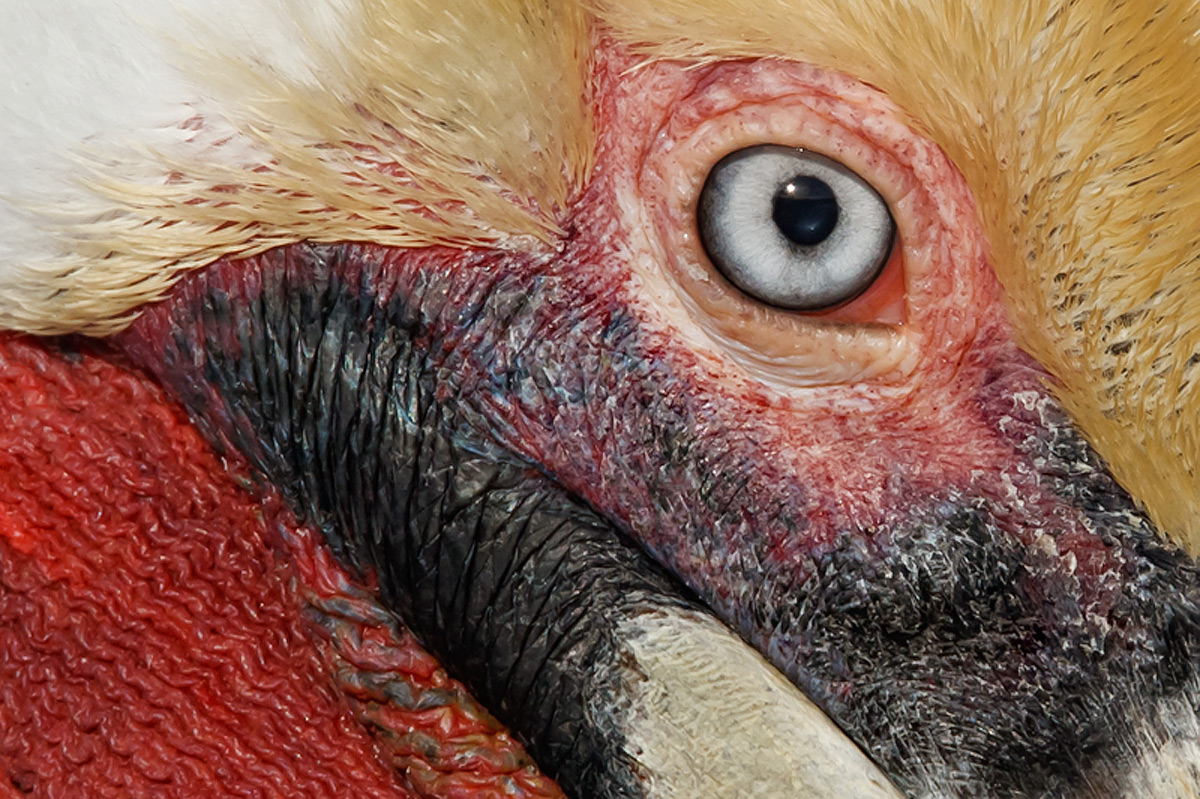
|
|
This tight face shot of a California Brown Pelican was was created at LaJolla, CA in January 2011 with the Gitzo 3532 LS carbon fiber tripod, the Mongoose M3.6 head, the Canon EF 800mm f/5.6L IS USM Autofocus lens,the Canon 1.4x EF Extender III (Teleconverter), and the EOS-1D Mark IV now replaced by the Canon EOS-1D X. ISO 400. Evaluative metering at zero: 1/500 sec. at f/13 in Av mode. To allow for focusing inside the minimum focusing distance of the old 600 I mounted a Canon Extension Tube EF 25 II and a Canon Extension Tube EF 12 II in front of the teleconverter. That forced me to use manual focus. Manual focus on the bird’s eye and re-compose. |
My Reply to Srdjan Mitrovic’s e-Mail
AM: Hi Srdjan, re:
SM: Art, thanks for the recommendations.
AM: YAW.
SM: I can add a 1.4x TCE to the new 80-400 . It becomes f/8 and but am uncertain about the quality.
AM: Though I have no personal experience with that lens and a TC I generally recommend against such combos as the speed of initial AF acquisition is slowed considerably. The same applies to the Canon 100-400mm.
SM: We have also 1.7x TCE and the 2x TCE that we could use on 200-400.
AM: Again, though I have no personal experience with that lens and a TC, I must say that recently I have been hearing many negative comments about the 1.7x TCE, most recently on the Bosque IPT where several folks stated that they owned the 1.7x TCE but have quit using it because of concerns about sharpness. And the Nikon 2x TCEs have been trashed by everyone I know who uses Nikon. Except for Todd Gustafson who regularly uses both the 1.7x TCE and the 2x TCE with his 600 f/4 Nikkor lens…. Everyone that I know is happy with the image quality from the 200-400 with the 1.4x TCE.
SM: If I understand correctly we should have at least 600mm full frame lens reach, correct?
AM: I am not so sure about that… See my comments above.
SM: D800s are 36 MP full frame bodies.
AM: With that file size using a shorter lens and cropping will produce some superb image files even with a large crop. With the 200-400 and the 1.4X TCE and the new 80-400 for hand held flight photography and your 36mp you should be more than fine….
Please let me know if you have any additional questions.
later and love, artie
ps: for more on Nikon lenses and TCEs see Big Lens Choices for Canon and Nikon–As I See Them….
The Great Group
We really have put together a great group of truly Happy Campers. Alan and Pat Lillich are both great friends and multiple IPT veterans. Both are accomplished photographers and Pat is a talented sculptress as well. I first met Zorica Kovacevic and Srdjan Mitrovic at Tierra del Fuego National Park where we hung out together and got more than a few great images of some Magellanic Woodpeckers. We then spent three great weeks together on a Cheesemans Antarctica/South Georgia/Falklands cruise. The always-smiling Scotsman (one “t” is correct) Malcolm MacKenzie is another mutliple IPT veteran. He lives in Connecticut. Rounding out the crew are newcomers Lex and Debbie Franks who will be traveling from Australia for their first Instructional Photo-Tour. We all look forward to meeting our soon-to-be new friends from Down Under.
Your Favorite?
Which of the three images above do you feel is the strongest? Be sure to let us know why.
|
Join me in San Diego for three great days of photography and learning. Click on the image to better enjoy a larger version. |
Announcing the San Diego Short-Notice Small Group IPT. January 15-17, 3-Full Days: $1049. Meet and Greet after dinner on your own at 7:30pm on Tuesday, January 14, 2014. Limit 6.
We will get to photograph the California race of Brown Pelican in flight, resting, preening, cleaning their bill pouches, and talking to their neighbors by tossing their bills high in the air. The afternoon sessions will feature Marbled Godwits, several gull species, and Wood and Ring-necked Ducks. If we have a cloudy morning we will get to photograph Harbor Seals. You will learn to get the right exposure every time, to see the best situation, to think like a pro, to create sharp, pleasing images, and to understand the joint effects of light and wind on the birds. All in a small group with tons of individual attention.
A $500 non-refundable deposit is required to hold your slot for this IPT. Your balance will be due no later than January 7, 2014. The balance is alo non-refundable. If the trip fills, we will be glad to apply a credit applicable to a future IPT for the full amount less a $100 processing fee. If we do not receive your check for the balance on or before the due date we will try to fill your spot from the waiting list. If your spot is filled, you will lose your deposit. If not, you can secure your spot by paying your balance.
If you are planning to register please shoot me an e-mail.
Then please print, complete, and sign the form that is linked to here and shoot it to us along with your deposit check (made out to “Arthur Morris.”) Though we prefer a check, you can also leave your deposit with a credit card by calling the office at 863-692-0906. If you register by phone, please print, complete and sign the form as noted above and either mail it to us or e-mail the scan.
If you have any questions, please feel free to contact me via e-mail
San Diego Site Guide
Can’t make the IPT? Get yourself a copy of the San Diego Site Guide; it’s the next best thing to being on an IPT. Nearly 30 years of San Diego bird photography revealed in one fell swoop.
Great buy: Used Canon 800mm f/5/6L IS Lens for Sale
Friend and multiple IPT-veteran Monte Brown is offering his lightly used Canon 800mm f/5.6L IS lens in excellent condition for sale for $9,500. Purchase includes the lens case and hood, the 4th Generation Design Low Foot, the original foot, a LensCoat, the original invoice and the original Canon shipping carton. The lens was purchased new from B&H in April 2009 and was recently underwent a pre-sale clean and check by Canon. The buyer pays insured shipping via UPS Ground to US addresses only. The lens will be shipped only after your check clears.
The Canon EF 800mm f/5.6L IS USM Autofocus lens sells new for $13,223.00 so you will save a bundle on a great lens. No need to ever use a 2X…
If interested you can contact Monte by phone at 1-765-744-1421 or via e-mail.
Last Year’s Grand Prize winning image by Lou Coetzer
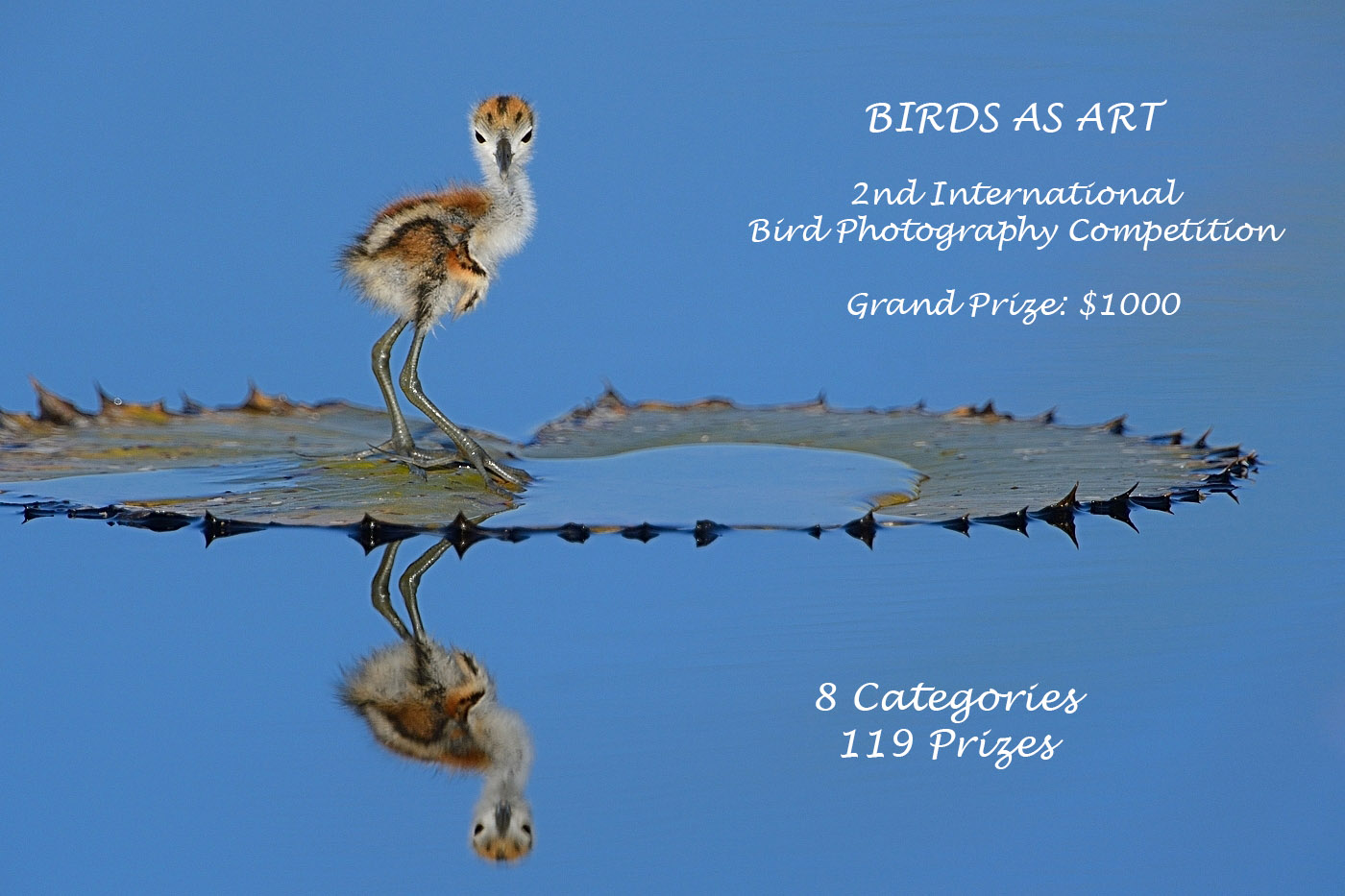
|
Time is Running Out!
BIRDS AS ART 2nd International Bird Photography Competition
The December 31, 2013 closing deadline is fast approaching.
Learn more and enter the BIRDS AS ART 2nd International Bird Photography Competition here. Twenty-five great prizes including the $1000 Grand Prize and intense competition. Bring your best.
Support the BAA Blog. Support the BAA Bulletins: Shop B&H here!
We want and need to keep providing you with the latest free information, photography and Photoshop lessons, and all manner of related information. Show your appreciation by making your purchases immediately after clicking on any of our B&H or Amazon Affiliate links in this blog post. Remember, B&H ain’t just photography!




Amazon
Everyone buys something from Amazon, be it a big lens or deodorant. Support the blog by starting your search by clicking on the logo-link below. No purchase is too small to be appreciated; they all add up. Why make it a habit? Because I make it a habit of bringing you new images and information on an almost daily basis.
Typos
In all blog posts and Bulletins feel free to e-mail or leave a comment regarding any typos, wrong words, misspellings, omissions, or grammatical errors. Just be right. 🙂
IPT Info
Many of our great trips are filling up. You will learn more about how to make great images on a BAA IPT than anywhere else on the planet. Click here to learn about the just-announced 2014 Bosque IPTs. And click here for the schedule and additional info.

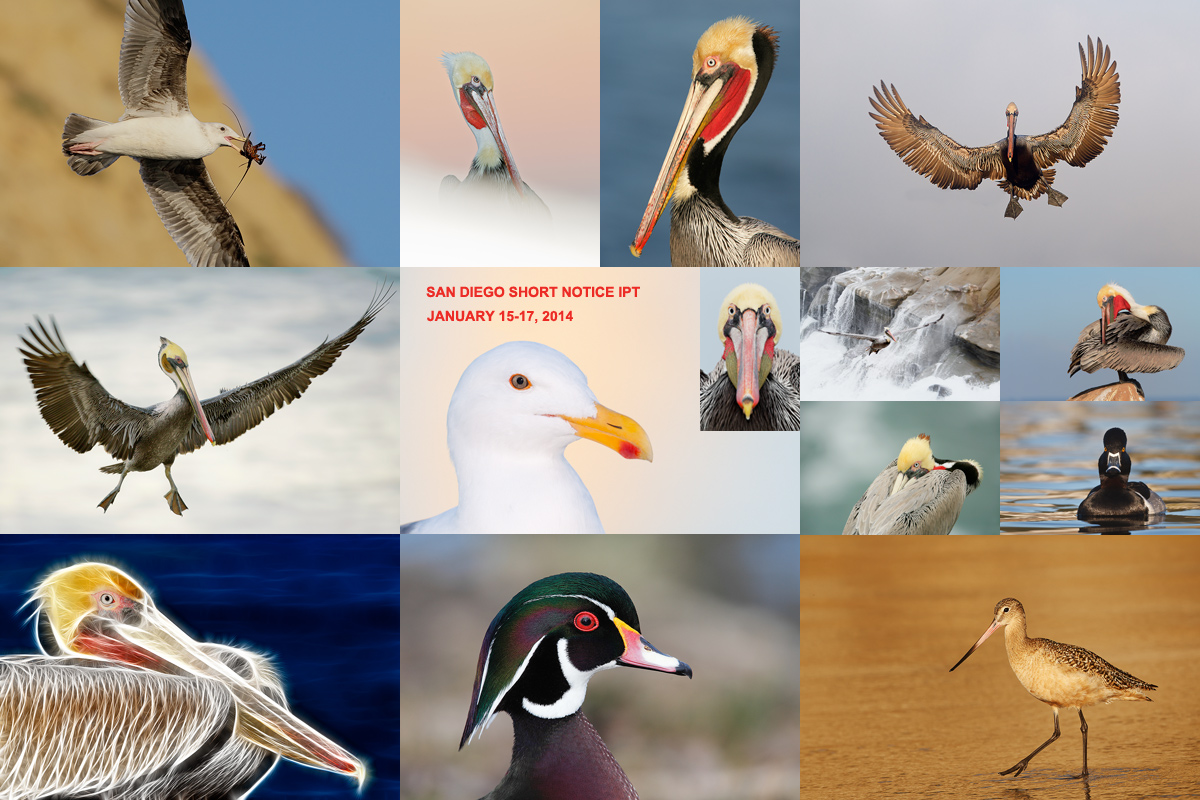













Hi Artie,
First of all I would like to wish everyone at BAA a Merry Christmas.
Second, not sure what’s gone wrong, but I have not received a bullitin from BAA since 15th Dec. Has anyone else had issues or is it just me ?
Cheers,
Ron
Thanks and ditto Ron. Are you talking about blog notices or the BAA Bulletin? We never take anyone off the lists :). Either way, you can re-subscribe by clicking on the Subscriptions tab on the right side of the orange bar near the top of the page:) best, artie
Thanks Artie,
I was talking about blog notices. Followed your advice and all is now OK 🙂
Thank you !!!!!!!
Love your blog – learning lots. Will link through your website for a 500II or 600II in January. Which one above? I keep changing my mind! #3 nabs my attention right away, demanding detailed study. #2 brings me back again and again for the regal pose and the saturated colors. #1 has those awesome repeating geometrical shapes in addition to the unexpected pose.
Many thanks for the affiliate link promise and for your kind words. Glad that you like the image. Shoot me an e-mail if you are having a hard time deciding between the 500II and the 600II 🙂 We can also help you out with a Lens Coat for your new lens, a Mongoose M3.6 a new tripod if you need one, and the right low foot. later and love, artie
Love # 3! The first two don’t come close to the impact of #3.
Btw I am a Nikon shooter and have no problem creating sharp images with the 1.7x and 2x tc’s. They are both excellent! In fact the 1.7x tc provides a great balance between focal length extension and auto focus speed. What you are talking about sounds like user error. If Todd Gustafson can create sharp images with the two tc’s, why can’t your students? Pretty sure it’s not the gear 🙂
#3 in your opinion of course :). The folks who do not like the 1.7X and the 2X are more excellent photographers and friends than clients or students. And as I have been saying, the word on the street with regards to those two TCEs has been pretty much universal.
I am glad that you are getting good results with them. What lens or lenses are you using them with?
Yes, #3 is just my opinion 🙂
About the tc’s, this is the first time I have read anything bad about them. Really! The new versions of both the 1.7x and 2x are great! The old (Version II) 2x was…crap! 🙂 Hard to believe anyone would get terrible results with those tc’s. I use the 1.7x with a 70-200 2.8, 300 f/4 and 500 f/4 lenses and the 2x with the 70-200 2.8 and occasionally with the 500 f/4. Using the D800 body.
The only reason I can think of, for photographers not getting the results they want with these tc’s is the need for a micro adjustment with a particular combination. I had this issue as well, before a workshop instructor (Nikhil Bahl) figured out the problem and helped me with the micro adjustment. It seems like, the longer the focal length the more the need for the micro adjustment; for precise focus and the best results, in terms of sharpness. Would you agree?
Thanks for the update. I try to keep all of my gear micro-adjusted. We will see what the boys and girls have to say.
All 3 images are amazing, but I like #3 the best- I like seeing things “different” and this image fits the bill! I find it the most interesting of the 3, causing me to look closer and study it.
Thanks a stack Wendy! artie
I’m struggling with the same problem but not with your insight. Looking at pictures on the web, there are photos are coming from the crane area at what would be 640-800mm on a full frame camera but most are not. Between the airlines and my age I can’t lug as much stuff as I used to. What you are showing here is all over 1000mm equivalent on a full frame camera. Most of what I see from japan is not that tight. Whether that is because of style or the difficulty of getting the equipment half way around the world, I don’t know. I’m seriously looking at the sigma 50-500 and a long lens. I used a 28-300 in Antarctica with a 500 and it was a great combination reducing the number of lens changes. I’m having difficulty figuring out where the 200-400 fits in. A little heavy and bulky for me and flight shooting, a little short although you have been successful with the double 1.4 combination.
Few if any have my insight :). Traveling with long lenses has always been difficult. Note: image #2 is effective 780mm, not “more than 1000mm equivalent on full frame.” I made lots of head portraits on my last trip to Japan, most with 800/1.4X III but some with shorter focal lengths. Do a search in the little white box in the upper right corner here for “Japan.” Follow all the links and you will see lots of my images from the first trip. Getting to Japan with lots of gear is no different from getting to Podunk, Iowa.
Do you own the 500 II? As far as the 200-400, I have written a ton about it. Start searching. You will find that I recommend it for most folks as a specialty lens for places like Antarctica, Africa, and the Galapagos.
So what is your perceived problem?
I stand corrected 780mm. Like you, I’m not happy with the prospect of hauling two super telephotos, the 200-400 or the 500 II or the 600 II on the same plane trip although I know people who have done it in Africa. There you are photographing from a vehicle and not on foot which helps. I’ve got a 200-400 and the 600mm II canon and access to a 500 II. I do not feel strong enough to use any of theses as a flight lens for any length of time even after taking Jim’s flight shooting class in FL. I’ve read your writings on the 200-400 and understand why it is great for Antarctica, Africa and the Galapagos. I enjoyed using it in Yellowstone this summer. For Japan, I’m afraid it is a little sort and I’m leaning towards taking the 600 even though the 500 is easier to travel with primarily because the 500 fits the thinktank international rollon. I’m gun shy about carry on after the problems I had in flying to Iceland last summer. I talked my way through but it was a nerve racking experience. What ever I do, that leaves the 70-200 or the 300 for birds in flight. The 70-200 would normally go anyway.
I am always happy. As it says in the blog posts on the summer safari, I took both the 600 II and the 200-400 on the plane. Yes, all three are hard to hand hold for any length of time for many folks. I think that you meant a little short. Nerve-wracking is a choice 🙂
Yes short. I need a proof reader. I may go for nerve racking. The 600 will fit into the international but in doing so you distort the bag. If it were hit on the handle end, it has little cushion.
That’s why I used the Think Tank Airport Security for most of my travel :). artie
I like the first one. It just makes me happy to look at it. All three are terrific, of course.
Thanks a stack David!
I love the first picture. The pose is great and I like how the pelican is on the highest part of the rock.
I think the third is the strongest by far for the graphic design, strong colors, and unusually close view. My favorite is the first though. Those guys are so improbable when on the ground and hunched down like that. I wish it was framed a tiny bit lower though, so the lower left corner rock was more connected to the center hump.
Thanks Alan. A pose as in #1 is very rare. I am fine with the way that I handled the rock. I could have gotten rid of the small part of the rock but opted not to.
#3. I always love a shot that shows me detail that my un-aided human eye can’t see. Plus the composition, with something in every corner leading back to the subject.
#2. I like the color, sharpness, composition and head angle.